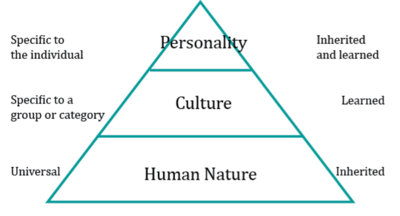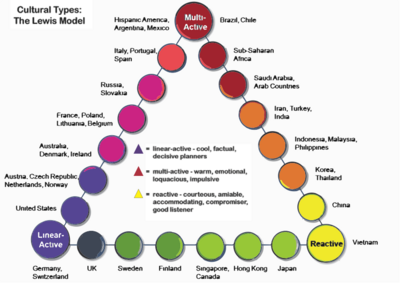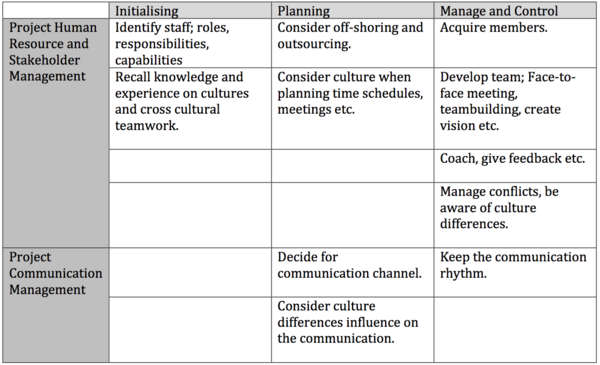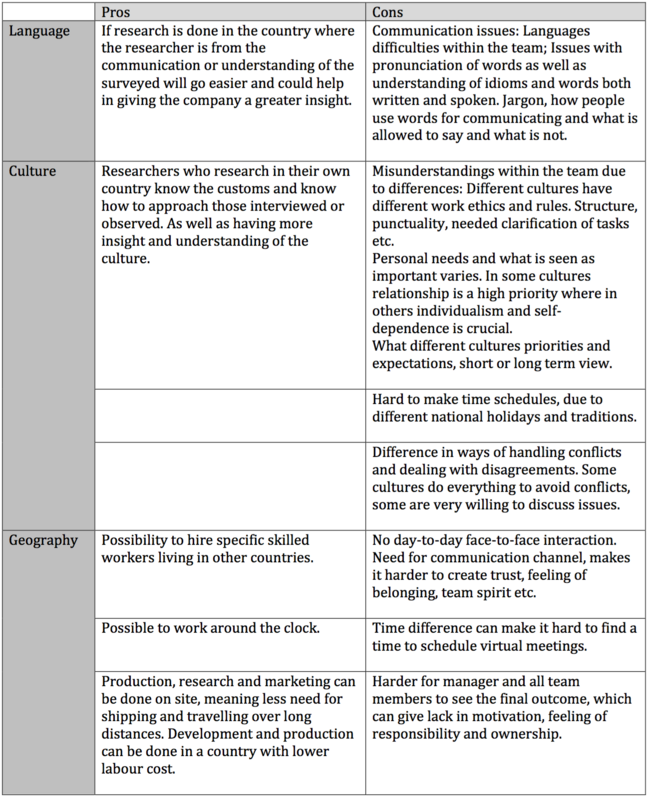Managing a Virtual Cross-Cultural Team in Global Project Management
Cross-culture, language and geographical diversity are some challenging areas that can influence the work of a global virtual team. Such a team is where the members are geographically outspread and do not communicate face-to-face. The team members might have different cultural backgrounds, language barriers or may be located in different time zones. These types of differences influence the communication and the understanding within the team, which can lead to misunderstandings or disagreements. In project management this is something to consider, when trying to predict, manage and control possible issues and delays within the work as well as the execution of the work. To use the global project management as an advantage it is important to be aware of the differences, understand where the different stakeholders or members of the team come from and use the differences to your advantage. This article focuses on the challenges, which should be dealt with throughout the process of managing a global project. Three of the project management knowledge areas within a project management framework will be discussed with focus on a virtual teamwork. The areas in focus are; project human resource, communication and stakeholder management.
Contents |
Introduction[1]
To grow as a large company with an international arena, teamwork across different countries is inevitable. Focus on global project management (GPM) is important when dealing with larger projects on a global scale. The company might want to outsource or offshore parts of the developing of the product or service. This could be done in order to save cost and time, make the process more effective or acquire certain skills. E.g. local people could do the market analysis, the exploration and the sale of the product/service. As well, the production or parts of it could take place either close to where the raw materials are extracted, in the country where the product is to be sold or in a country where the labour is cheaper. As a project manager you have to be able to handle different stakeholders; within your project team, the market, suppliers and possible collaborating companies. In order to make a team work ten principles could be followed. The PMI standard of project management (PM) [2] framework entails ten main knowledge areas. A project manager will have to master these throughout the five project process stages: initiate, plan, execute, monitor and control and closing the project. This article will consider the areas where GPM mainly differ from “regular” PM. The three areas in focus in this article are; Project Human Resource, Communication and Stakeholder Management. The remaining seven areas will not be addressed in this article.
Definition of Culture
To see how culture influences a team it is important to understand what culture is. Cambridge Dictionary[3] defines culture in different ways;
National culture: “the way of life, especially the general customs and beliefs, of a particular group of people at a particular time”.
Culture at a workplace: “the ideas and ways of working that are typical for an organization, and that affect how it does business and how its employees behave”
Organizational culture: “the types of attitudes and agreed ways of working shared by the employees of a company or organization”
These definitions all describe culture as something that is shared by a group of people, whether it is in a company or a nation, and that culture influences the way a person thinks, feels and acts.
Culture’s Influence on a Person and a Team [4]
How a person thinks and behaves are influenced by the human nature, culture and personality as seen in figure 1. E.g. all humans by nature eat when they are hungry. Culture could affect which spices they add to their food. Personality could influence what the person likes or does not like to eat. The human nature is universal and inherent. The culture is acquired by a specific group or category. Personality is inherent and acquired and is specific to the individual.
In a cross-cultural team the members can have very different cultural backgrounds, which can affect their thoughts, behaviours and how they interact with others. Figure 2 illustrates Lewis’ model of cultural types [5]. If the members have very different ways of doing things this can lead to disagreements and conflicts. In the next section these differences as well as language barriers and location will be discussed.
Pros and Cons in Global Project Management (GPM) [6]
In many big companies such as Coca-cola, Toyota etc. cross-cultural virtual team work is inevitable. As described in the previous section culture, language and geography can have a great influence on project management. In Table 1 the pros and cons of GPM are described.
Ten Principles of Making Virtual Teams Work [8]
As described before the company can have different reasons for off-shoring or outsourcing parts of the process. However to keep up the efficiency it is important to be ready for issues that can occur. In order to avoid or deal with some of the issues, which can arise in a virtual team ten principles, can be taken into account.
1. Early Face-to-Face Meeting In communication theory it is commonly known that different types of communication media is richer than others, meaning some channels are more effective than others. On the top of the list of most effective communication media is face-to-face meeting. “Face-to-face is the richest medium because it provides immediate feedback so the interpretation can be checked” [9] More than just being a communication media, meeting people in real life is also more effective when building relationships. It is important for a team to establish an essential foundation for the further work at the beginning. As well, meeting annually or more frequently improves the feeling of connections and enhances the shared vision.
2. Align Roles within the Team In the global team with no day-to-day meetings it is crucial to have detailed clarification of the different roles, tasks and responsibilities to make it easier to coordinate the work. As well reviewing the work is important to keep track of the time, cost etc.
3. Structure the Communication In order to have effective communication with as few misunderstandings or disagreements as possible, it is a good idea to make a communication charter, where the norms, conversation rules, which media to use in which situations are established. E.g. using emails for reply could be inefficient in some cases but very practical in other. Also interruptions or a noisy ambience can be very disturbing for the communication flow.
4. Deciding for the Best Possible Communication Channels Communication programs on the market are constantly changing, and developers add new features, new names etc. to the programs. However it is important not to be blinded with all these options. Maybe the best possible media is not the newest. It might be that it is too advanced for some members, the connection is slow, the reliability is low and so on. It is important to include all team members on the platform to not impair the communication.
5. Creating and Maintaining Team Rhythm To enable coordination of work tasks, regular communication is needed. When being a virtual team with rare face-to-face meetings and with no daily interaction it is easy to loose contact. It is important to make some routines and schedule meetings regularly. Also the meeting time could be unfortunate for some members due to times differences. Make sure not to burden the same members every time, by changing the times regularly.
6. Create Common Language Understanding and Use In a cross-cultural team, members might not all have the same mother tongue. Therefore it is important to agree on the communication language within the team and also decide what specific important words mean. A list of words and meanings could be shared among the team members.
7. Creating Room for a Virtual “Coffee Break” When working with people in the same building or at the office next door it is easy to socialize and build a relationship. When having a virtual team, it is important to still have focus on this aspect. A way of doing it is by having each meeting starting with checking in on each team member, what is going well and what is challenging. Other ways are to use online networking platforms or make virtual team building exercises.
8. Ensuring and Tracking Commitment It is easy for a project manager to keep track and know if the team members are up to date with their tasks when he meets the members on a daily basis. However when managing a virtual team it is harder to do that. To keep milestones and to engage in commitment an online dashboard on deliverables can be used. With this tool the project manager is able to plot the tasks. Allowing all members to see the board makes it possible for them to see where they should be and keep them responsible for finishing their tasks on time.
9. Engage Team by Sharing Leadership Using shared leadership, as a way of engaging the members can be useful in a virtual team. Smaller tasks such as facilitating a team building exercise or helping a new team member getting to know the routines can help engaging team members and letting them take part in the leadership.
10. Individual Coaching and Leading To enhance productivity and commitment one-to-one meetings between project manager and team members are important and should be a part of the weekly routines. In this meeting the members should give updates, get feedback but also be reminded on their role in the project and the common vision.
Improving a PM Process in a GPM [10]
In this section the knowledge areas; Project Human Resource Management, Project Stakeholder Management and Project Communication Management will be discussed in a GPM context. The ten principles as well as theory on cultural differences will be addressed in the context. To narrow it down this section will focus on a cross-cultural virtual team. However many of the approaches can directly be translated to interaction with other stakeholders such as business partners etc. Due to the many overlaps between Project Human Resource Management and Project Stakeholder Management these two areas will be looked at together in one section. Within each process step some matters should be taken into account when the team members are geographically dispersed, might have language barriers and different cultural backgrounds.
Table 2 gives an overview of the different activities within the different knowledge areas. However be aware that the knowledge areas might overlap which means that one activity in human resource management could also be seen as an activity in communication management. Each activity is explained in the sections below.
Project Human Resource and Stakeholder Management
Within these two knowledge areas there are four steps; planning, acquiring, developing and managing the team.
Planning human resources
- Define needed project staffing; roles, responsibilities and capabilities. In a global team it is important to consider where the needed skills are available. It might be that the most qualified people who have the required knowledge within a specific area live in another country. Just like as mentioned in pros and cons, a researcher researching in own country has an advantage due to culture and language understanding. However also pay attention off-shoring or outsourcing could have disadvantages, due to cultural, language and time difference within the team.
Acquire a Project Team
- Acquire the needed team members.
Develop a Team
- When developing a team it is important to consider interpersonal skills such as cultural background etc. As a project manager it is also important to understand own cultural background to find common ground, identify similarities and differences within the team. In order to get insight and understanding of the individual team members tools like attitudinal surveys, belbin test, interviews, ability tests etc. can be used. These tools can help the project manager when proactively trying to avoid conflicts or understanding how to possibly handle future conflicts. That can also lead to more efficiency, trust and commitment within the team.
- Create trust and agreement within the virtual team: As described earlier, face-to-face meetings are one of the best ways to create trust and understanding. Having an early meeting enhances the chances of a good group dynamic [11].
- Another way to enhancing the level of understanding and trust within a team is by making team-building exercises [12].
- Develop informal socialization customs such as checking up on each team member, making a virtual room for informal socialization or similar.
- Aligning roles, tasks and responsibilities for each member.
- Make a resource calendar to ensure tasks are solved on time, consider time zones and days off. Remember that other cultures have other holidays and traditions.
Managing a Project Team
- As described in the ten principles it is important to keep a rhythm within the virtual team. Keeping the meeting plans, ensuring that every team member is engaged in the work and takes responsibility.
- Share leadership by giving specific tasks to specific team members.
- Listen to the members and provide feedback and coaching.
- In a virtual team as in every other team, conflicts are likely to occur. Some approaches can be taken into account for resolving conflicts that can be a threat to the project: Solving the issue by confronting it, compromising, avoiding confrontation, smoothening out and forcing the team to move on [13]. The project manager should be aware that different cultures react very differently on conflicts. Some cultures are very willing to confront, take criticism as a way to improve, whereas some are more likely to avoid the conflict and confrontation in order not to get the team out of balance [14].
Project Communication Management[15]
In project communication management the focus is on planning, managing and controlling the communication.
Plan Communication
- Determine appropriate channels for communication, and be aware that it might not be the newest technology that your team will benefit the most from. Maybe some members need training in using a specific communication media.
- Establish ground rules, communication rules and create a common language and common understanding, e.g. a list of important words and their meaning.
Manage and Control Communication
- As a project manager it is always important to be aware of different communication techniques and even more crucial it becomes when the communication is within a cross-cultural team. Generally a message should have a purpose. Is it to control, motivate, express an emotion or inform. However when communicating, there is always some background noise which can disturb the receiver’s perception of the message. Too much information could give an overload meaning that some of the information might not be recorded. Emotions could influence how the receiver interprets the message. Language barriers can make it hard for some to understand the meaning etc [16]. Figure 3 shows a message’s way from the sender to the receiver and the receiver’s feedback. In a cross-cultural team it is important to remember that the members have very different backgrounds, and therefor might interpret the message differently. The way a person interprets a message can be influenced by different dimensions as mentioned. However the manger can control or influence this by choosing an appropriate style, using visualization and focus on appearing credible [17].
Conclusion
As described in the article there are many aspects that can influence a GPM process with a virtual team. However, by correctly managing the team it is possible to benefit in many ways. The project manager’s focus should be on how to deal with issues such as language barriers, geographical distance as well as cultural differences within the team.
Further Reading
In this article many of the aspects are very briefly described. Some of the references go much more in depth. In order to get more information on this topic I would recommend the following literature:
Global Project Management: Binder, Jean. "Chapter 1." Global Project Management: Communication, Collaboration and Management across Borders. Aldershot: Gower, 2007. 21-42. Print. This book goes in depth with a lot of global project management aspects. It describes different communication tools, culture across the world and much more.
A Project Management Process: A Guide to the Project Management Body of Knowledge (PMBOK Guide). 5th ed. Pennsylvania: Project Management Institute, 2013. Print. This book describes all of the teen knowledge areas within a project management process.
Annotated Biography
- ↑ Binder, Jean. "Chapter 1." Global Project Management: Communication, Collaboration and Management across Borders. Aldershot: Gower, 2007. 21-42. Print. Summary: Introduction to culture in GPM. Description of Hofstede’s and Thrompenaars’ cultural dimensions and the impact on GPM
- ↑ A Guide to the Project Management Body of Knowledge (PMBOK Guide). 5th ed. Pennsylvania: Project Management Institute, 2013. Print. Summary: Project Management Institute’s standard for Project Management. Describes a project management process and ten knowledge areas within this process
- ↑ "Culture Meaning in the Cambridge English Dictionary." Culture Meaning in the Cambridge English Dictionary. Cambridge University Press 2015, 2015. Web. 24 Sept. 2015. http://dictionary.cambridge.org/dictionary/english/culture. Summary: Cambridge online dictionary. Definitions on culture
- ↑ Hofstede, Geert. "Dimensionalizing Cultures: The Hofstede Model in Context." Online Readings in Psychology and Culture 2.1 (2011): n. pag. Web. http://scholarworks.gvsu.edu/cgi/viewcontent.cgi?article=1014&context=orpc Summary: The article is a brief description of the six dimensions of national cultures of Hofstede’s model
- ↑ Lubin, Gus. "The Lewis Model Explains Every Culture In The World." Business Insider. Business Insider, Inc, 06 Sept. 2013. Web. 24 Sept. 2015. http://www.businessinsider.com/the-lewis-model-2013-9?IR=T. Summary: The article describes Lewis’ model of all the cultures in the world. The idea is to give an overview of cultures plotted in three categories; Linear-active, multi-active and reactive.
- ↑ Oertig, Margaret, and Thomas Buergi. "The Challenges of Managing Cross‐cultural Virtual Project Teams." Team Performance Management Team Performance Management: An International Journal 12.1/2 (2006): 23-30. ResearchGate. Jan. 2006. Web. 24 Sept. 2015. http://www.researchgate.net/profile/Thomas_Buergi/publication/235263716_The_challenges_of_managing_cross-cultural_virtual_project_teams/links/00b7d51e3d0081be81000000.pdf Summary: Article describes the challenges which has been seen in cross-cultural virtual teams
- ↑ Blomqvist, Kirsimarja, and Kaisa Henttonen. "Managing Distance in a Global Virtual Team: The Evolution of Trust through Technology-mediated Relational Communication." Strategic Change (n.d.): n. pag. ResearchGate. Mar. 2005. Web. 24 Sept. 2015. http://www.researchgate.net/profile/Kirsimarja_Blomqvist/publication/227903160_Managing_distance_in_a_global_virtual_team_the_evolution_of_trust_through_technologymediated_relational_communication/links/54a8e51f0cf257a6360be3d4.pdf Summary: The article describes trust building witin a virtual team and which communication medias could be used in this process.
- ↑ Watkins, Michael. "Making Virtual Teams Work: Ten Basic Principles." Harvard Business Review. N.p., 27 June 2013. Web. 24 Sept. 2015. https://hbr.org/2013/06/making-virtual-teams-work-ten/ Summary: The article describes ten principles which can help in improving in teamwork in a virtual team.
- ↑ Daft, Richard L., and Robert H. Lengel. "ORGANIZATIONAL INFORMATION REQUIREMENTS, MEDIA RICHNESS AND STRUCTUR." Management Science (1986): n. pag. CNDLS. Web. 24 Sept. 2015. https://blogs.commons.georgetown.edu/cctp-745-spring2010/files/organizational-information-requirements.pdf Summary: The article discuss communication medias used within an organization
- ↑ A Guide to the Project Management Body of Knowledge (PMBOK Guide). 5th ed. Pennsylvania: Project Management Institute, 2013. Print. Summary: Project Management Institute’s standard for Project Management. Describes a project management process and ten knowledge areas within this process
- ↑ Binder, Jean. "Chapter 3." Global Project Management: Communication, Collaboration and Management across Borders. Aldershot: Gower, 2007. 51-59. Print. Summary: Description of trust building in GPM. Establishing, maintaining and keeping long-term trust
- ↑ Osman, Hassan. "3 Fun and Easy Virtual Team Building Activities." The Couch Manager. N.p., 20 Apr. 2015. Web. 24 Sept. 2015. http://www.thecouchmanager.com/3-fun-and-easy-virtual-team-building-activities/. Summary: Article on three different activities for team building in a virtual team
- ↑ Binder, Jean. "Chapter 4." Global Project Management: Communication, Collaboration and Management across Borders. Aldershot: Gower, 2007. 63-65. Print. Summary: Describes the sources of conflicts, the levels, how it can influence I GPM and the steps to managing conflicts.
- ↑ Ford, John. "Cross Cultural Conflict Resolution in Teams." Cross Cultural Conflict Resolution in Teams. N.p., Oct. 2001. Web. 24 Sept. 2015. http://www.mediate.com/articles/ford5.cfm Summary: Article describes how different cultures handle conflicts
- ↑ Binder, Jean. "Chapter 7, 8, and 9." Global Project Management: Communication, Collaboration and Management across Borders. Aldershot: Gower, 2007. 91-118. Print. Summary:
- ↑ "Shannon and Weaver Model of Communication." Communication Theory RSS. N.p., n.d. Web. 24 Sept. 2015. http://communicationtheory.org/shannon-and-weaver-model-of-communication/. Summary: Describing Shannon and Weaver Model of Communication."
- ↑ "Cross Cultural Communication." Communication Theory RSS. N.p., n.d. Web. 24 Sept. 2015. http://communicationtheory.org/cross-cultural-communication/. Summary: This article describes cross cultural communication





